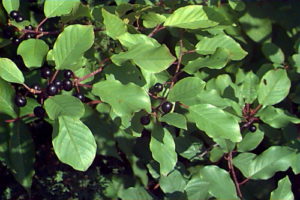Stop Invasive, Destructive Buckthorn

The phrase “exotic species” might sound mysterious or romantic, but to the native plants of Illinois, these outsiders offer nothing but a one-way ticket to extinction. Exotic or invasive species are those forms of plant or animal life that are not part of an established ecosystem. Exotic species tend to crowd out native species, often destroying the native ecosystem in the process.
Here in northern Illinois, exotic species such as Buckthorn took hold in fertile soil and have become a serious threat to our native ecosystems. They grow in our natural areas, and they pop up consistently in our backyards— crowding out trees, brush, grass and natural yard lines. Buckthorn tends to produce leaves well before our native trees and shrubs. This lets the exotic Buckthorn begin growing before the native plants even wake up for the spring. And, those fast growing leaves of Buckthorn shade the natives, taking away the vital sunlight that promotes healthy growth.
Buckthorn can be cut back and destroyed in early spring and late fall. It is easy to identify since it develops leaves earlier than natives and keeps those green leaves growing long after most native trees have dropped colorful fall leaves to the ground.
Many exotic invasive species got their start when introduced into gardens by property owners. If you are planning a garden project, use an abundance of native. You’ll be surprised how many beautiful, indigenous flowers and grasses graced the prairies of Illinois.
Although six varieties of Buckthorn have been illegal in Illinois since 2003, preexisting growth continues to cause extensive damage and threaten the ecology of our area. You can help control and growth and spread of this exotic invasive species in a number of ways.
First, be on the lookout for it in your own backyard. Also, the Sierra Club promotes outdoor workdays here in Cook County’s northwest suburbs, including our own nearby forest preserve. You’ll learn to identify the exotic invasive species, how to control their invasive nature, and you’ll be able to see the difference you’ve made right away. The information you learn may someday help your own yard. A few hours of your time in the spring and fall can make a difference!
Information from the Northwest Cook County Sierra Club


